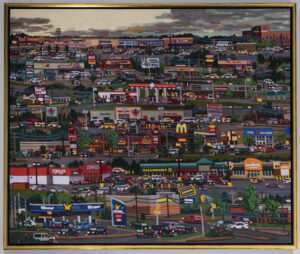Jack Bishop
Strip-Stack (2012)
Oil on canvas
Jack Bishop is originally from Quispamsis NB and received a BFA from NSCAD University. He has received creation grants from Arts NB, Arts NS, and the Canada Council for the Arts. His work is in numerous public and private collections across Canada including The NB Art Bank, The NS Art Bank, The Canada Council Art Bank, The Department of Foreign Affairs, the Beaverbrook Art Gallery, TD Bank and McCain Foods. Jack now lives in Halifax and works daily from his studio space above the Army Navy store on Agricola street in Halifax’ north end.
Bishop has recently dubbed his urban landscape paintings as “Brandscapes”. He explains:
“The paintings portray colourful and busy landscapes but also present a dark realism, revisiting the Canadian landscape tradition in terms not of natural but of commercial space, where ubiquitous retail outlets dictate use of the land and proclaim its occupation. The crowded compositions map out a “Geography of Nowhere”, a term coined by the author James Howard Kunstler in his 1993 book of the same name exploring the effects of sprawl, civic planning and the automobile on American society. I grew up in a small community amidst residential subdivisions and a short highway commute through the sprawl of commercial retail centres. This sort of nowhere typical of the outskirts of large North American cities has become the focus of my paintings.
My process involves taking lots of photography, scouting points of reference in business parks and from scaling hills and foliage to capture overhead views. I then cut up and reassemble the photos into large photomontage studies. The photomontages serve as a way to develop and compile the space in my paintings; like an urban planner mapping and carving out a man-made labyrinth from the natural environment. The photomontages break away from a single frame of perspective and give me a means to create new and more interesting compositions. I like the way the space becomes activated, there are portions in which the scale is believable and others where it breaks down, like a glitch in the matrix.
The paintings become their own fabricated environments; where placement of advertising, roads and infrastructure break up otherwise picturesque scenery. The spaces are deceiving, and perspective is skewed. Sparse foliage and encroached wildlife are integrated in small details. Seasonal effects of rain and snow also provide atmospheric frameworks. I want my paintings to represent a sense of excess and consumption, with subject matter open to interpretations ranging from romantic, folky or humorous to politically charged with appropriation and environmental impact.”
See also:
- CBC arts “Exhibitionists” documentary short “Jack Bishop doesn’t go to the woods to inspire his landscape paintings, he’s behind a strip mall”. https://www.cbc.ca/player/play/1536780867789
- Studio 21 Fine Art YouTube Channel artist video: https://www.youtube.com/watch?v=Xh4FFYTdnBY
- studio21.ca
- jackbishop.tumblr.com
